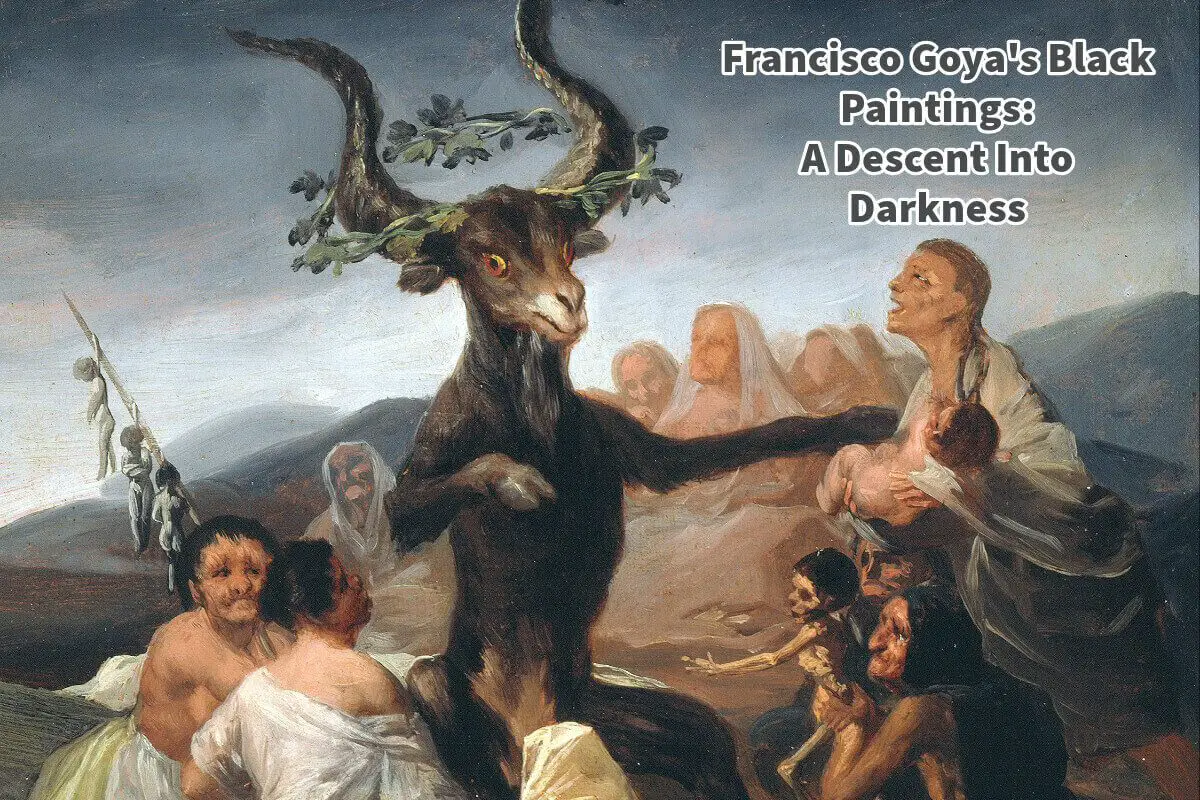The art world has witnessed a multitude of masterpieces, but few are as enigmatic and intensely personal as Francisco Goya’s Black Paintings. Perhaps no other paintings than the series of black paintings show the mind of Francisco Goya and what he was going through.
The painting is considered black due to its black theme and color. These haunting images brushed directly onto the walls of his residence, have intrigued scholars and art enthusiasts alike for nearly two centuries. They were not commissioned for anyone but were for Francisco Goya’s only personal use and enjoyment.
Table of Contents
- Francisco Goya’s Black Paintings: The Enigma On The Walls
- Francis Goya’s 14 Black Paintings Explored
- Atropos (The Fates), 1819 – 1823 By Francisco Goya
- Two Old Men, 1819-1823, By Francisco Goya
- Two Old Ones Eating Soup, 1819 – 1823, By Francisco Goya
- Fight with Cudgels, 1819 – 1823, By Francisco Goya
- Witches’ Sabbath, 1797–1798, By Francisco Goya
- Men Reading, 1819 – 1823, By Francisco Goya
- Judith and Holofernes, 1819 – 1823, By Francisco Goya
- A Pilgrimage to San Isidro, 1819 – 1823, By Francisco Goya
- Man Mocked by Two Women, 1819 – 1823, By Francisco Goya
- Pilgrimage to the Fountain of San Isidro, 1821 – 1823, By Francisco Goya
- The Dog, 1819 – 1823, By Francisco Goya
- Saturn Devouring His Son, 1819 – 1823, By Francisco Goya
- La Leocadia, 1819 – 1823, By Francisco Goya
- Asmodea, 1819 – 1823, By Francisco Goya
- Frequently Asked Questions
- Related Questions
Francisco Goya’s Black Paintings: The Enigma On The Walls
Goya’s residence, the Quinta del Sordo, witnessed his profound isolation and introspection during his later years. This isolation was not only physical – it was deeply emotional and psychological. Francisco Goya took the time to paint directly on his home’s walls and for his art.
Once celebrated as the court painter for Spanish royalty, Goya transformed into a recluse, grappling with the repercussions of grave illnesses that nearly claimed his life on two occasions. These brushes with mortality seemed to stir in him a profound contemplation of man’s dark nature and the world’s inherent cruelty.
The walls of the Quinta del Sordo, particularly in the dining and sitting rooms, became Goya’s silent canvas. One could argue they served almost as mirrors, reflecting the darkest recesses of his mind.
These paintings weren’t the result of a royal commission or a public demand. They emerged from an artist’s inner turmoil and the need to express, perhaps even exorcise, his demons.
Blacking Paintings – An Appropriate Name
The term “Black Paintings” might, at first glance, appear to refer to the color palette Goya utilized. And while it’s true that the shades are predominantly dark, the name carries a dual meaning.
Beyond the bleak and somber hues, the themes descend into nightmarish visions and grim portrayals of human nature.
Goya Never Intended The Black Paintings To Be Public
It’s compelling to note that Goya never intended these works for public viewing. They weren’t created for an audience, a gallery, or a benefactor.
These images were born from a place of raw emotion, without the constraints of societal judgment or the influence of public taste. Perhaps this is why they resonate so powerfully; they are unfiltered and unabashed in their grimness.
Since Francisco Goya hadn’t anticipated his paintings would ever face public scrutiny, he refrained from assigning them specific titles. Only after their discovery were these works christened with names – titles that essentially serve as descriptive snapshots of the vivid scenes Goya portrayed.
We Do Not Know Goya’s Exact Motivation For Paint These Paintings
Art historians have often pondered the motivations behind these paintings. Was it a direct reflection of Goya’s deteriorating mental state, a cathartic outlet for his anxieties, or a commentary on the turbulent socio-political environment of his time?
While the exact motivations remain speculative, the potent combination of Goya’s trials, deteriorating health, and societal chaos undoubtedly influenced this series.
The Black Paintings remain a powerful testament to the idea that art, in its purest form, emerges from the soul’s deepest recesses, unfiltered by external influences or societal expectations.
In Goya’s dark visions, we find an eternal reminder of the fragility and complexity of the human psyche.
Francis Goya’s 14 Black Paintings Explored
In the twilight of his life, the famed Spanish artist Francisco Goya took a daunting turn into the recesses of his mind, painting various subjects that reflected his disillusionment with humanity and his anxieties.
Known collectively as the “Black Paintings,” these masterpieces departed from Goya’s earlier, more conventional works. Delving into the darkness of his psyche, the series offers a revealing look into the mental and emotional state of the artist during a particularly tumultuous period in Spanish history.
Atropos (The Fates), 1819 – 1823 By Francisco Goya
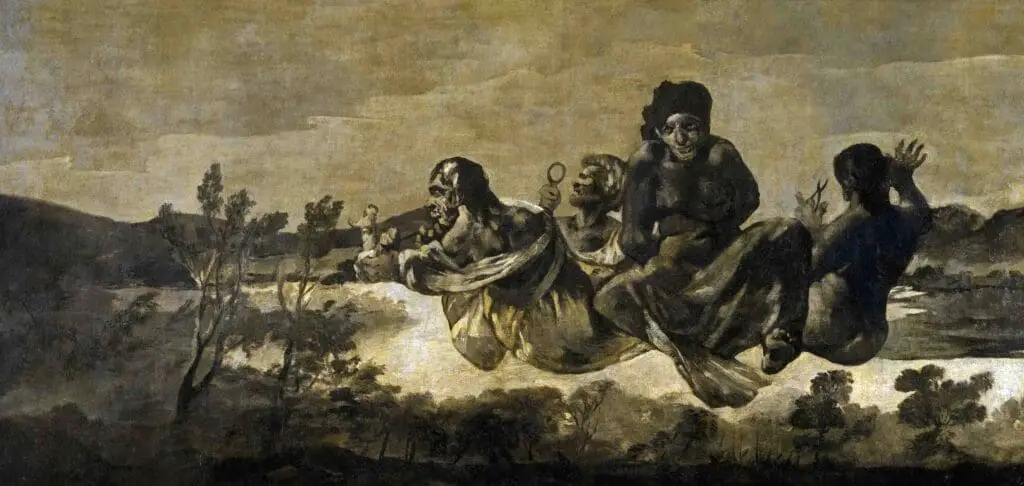
Drawing from Greek mythology, Goya depicts the three Moirai, or Fates, who control the thread of life of every mortal from birth to death. The painting evokes a sense of impending doom, hinting at the inevitability of death and the transient nature of life. It is a stark reminder of mortality and the limits of human control.
Two Old Men, 1819-1823, By Francisco Goya

A haunting portrayal of two elderly figures, this painting seems to encapsulate the frailty and transience of life. Their gaunt faces and lifeless eyes are reminiscent of specters, suggesting the proximity of death or perhaps the toll of a life full of hardships.
Two Old Ones Eating Soup, 1819 – 1823, By Francisco Goya
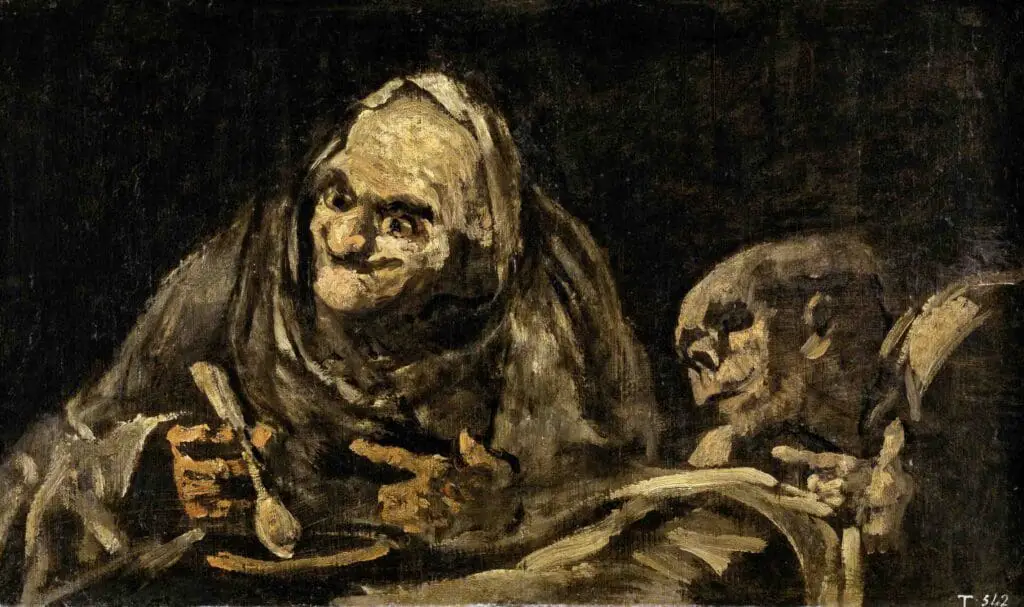
With one skeletal figure spooning soup into his gaping mouth while the other watches, Goya captures the raw, visceral reality of aging and the physical decline it brings. The act of eating, usually a symbol of life and sustenance, here becomes an almost grotesque representation of the relentless march of time.
Fight with Cudgels, 1819 – 1823, By Francisco Goya
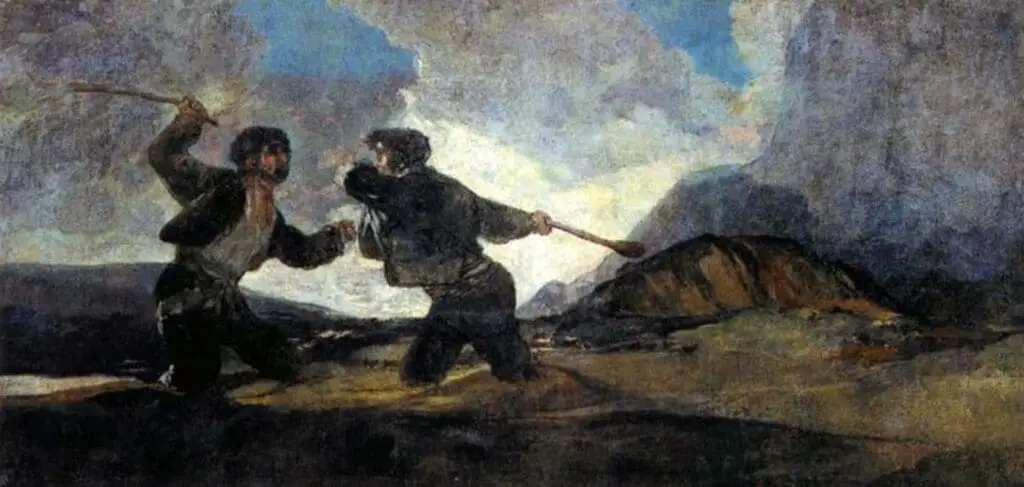
This artwork captures two figures engrossed in brutal combat. The barren landscape around them serves as a metaphor for the futility of their conflict. It could be seen as a critique of the ongoing civil strife Spain underwent during Goya’s lifetime.
Witches’ Sabbath, 1797–1798, By Francisco Goya
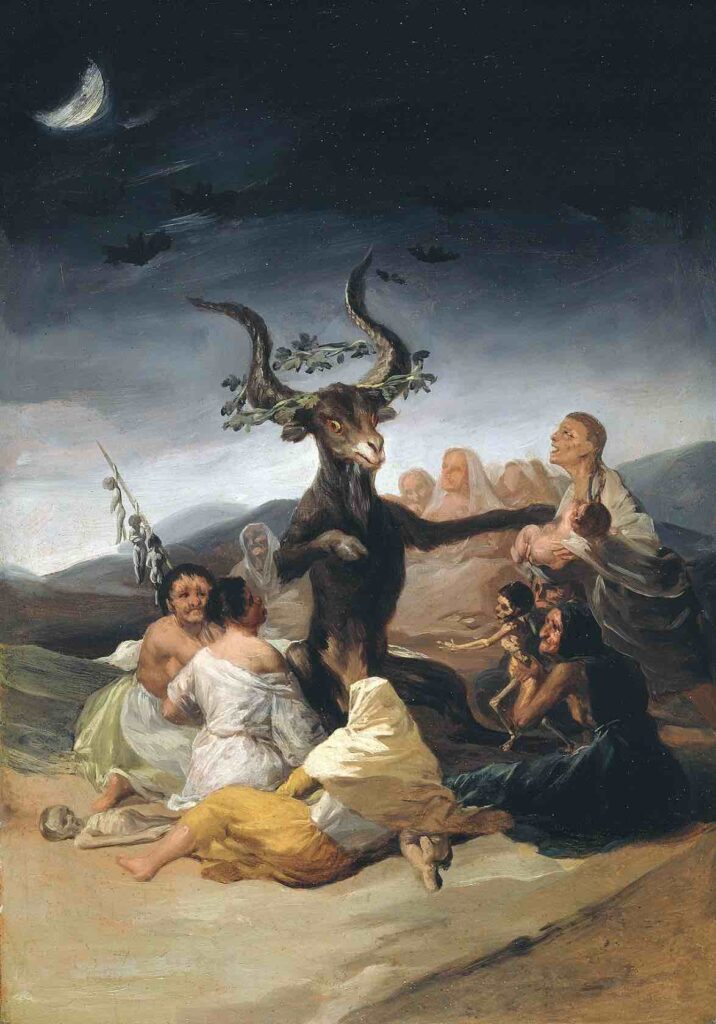
A dark representation of the supernatural, this painting depicts a gathering of witches paying homage to the goat-headed figure of the devil. It mirrors Goya’s disdain for the superstitious beliefs and practices prevalent in his time.
Men Reading, 1819 – 1823, By Francisco Goya

In an intimate scene where two men are engrossed in a document, this painting is subdued in its tone. While the exact narrative remains ambiguous, it’s speculated that Goya might be commenting on the intellectual movements of his time.
Judith and Holofernes, 1819 – 1823, By Francisco Goya
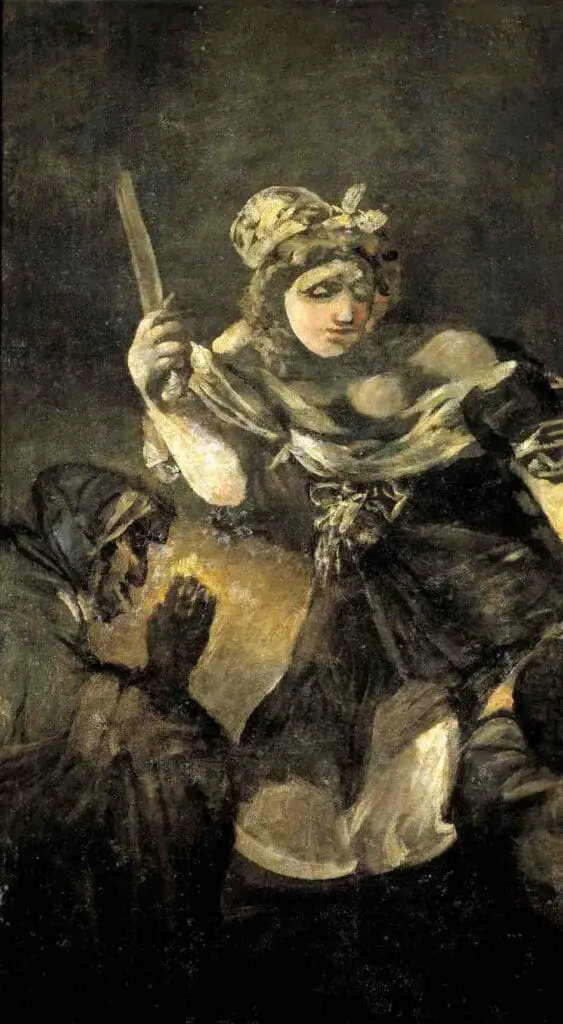
Drawing from the biblical tale, Goya paints Judith by beheading the Assyrian general Holofernes. The violent act, set against a dark background, reflects courage, sacrifice, and vengeance themes.
A Pilgrimage to San Isidro, 1819 – 1823, By Francisco Goya

This painting portrays a procession of eerily distorted figures making their way to the hermitage of San Isidro. The figures’ exaggerated features and the desolate landscape allude to the grim reality of life in post-war Spain.
Man Mocked by Two Women, 1819 – 1823, By Francisco Goya
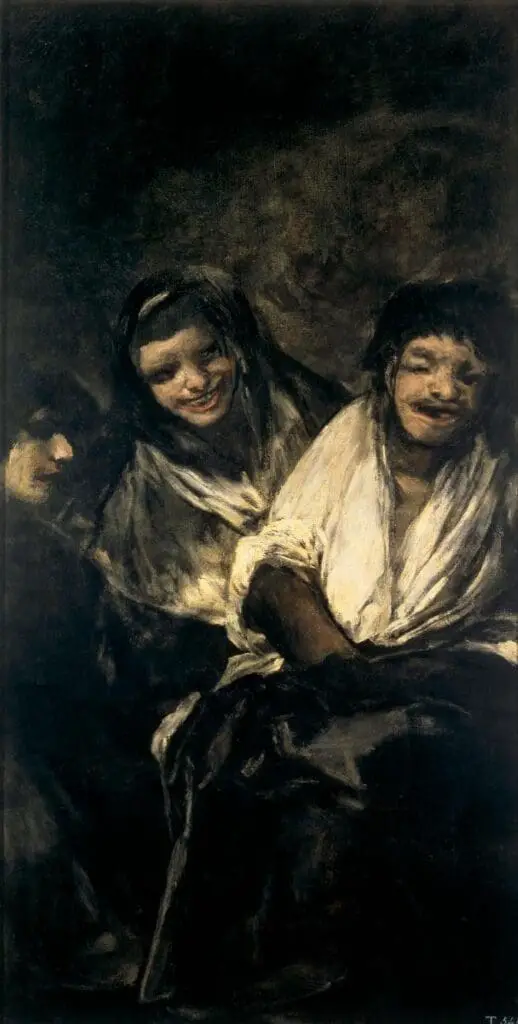
A stark representation of human cruelty, this piece showcases a man surrounded and taunted by two female figures. The scene, devoid of compassion, resonates with Goya’s jaded view of humanity.
Pilgrimage to the Fountain of San Isidro, 1821 – 1823, By Francisco Goya

Slightly more vibrant than its counterparts, this painting captures a group of people at the fountain of San Isidro. The scene is still imbued with Goya’s typical dark undertones.
The Dog, 1819 – 1823, By Francisco Goya

One of the most celebrated pieces of the series, it depicts a lone dog with its head raised, seemingly drowning in a vast expanse of brown. It’s a potent representation of isolation, despair, and the relentless weight of existence.
Saturn Devouring His Son, 1819 – 1823, By Francisco Goya
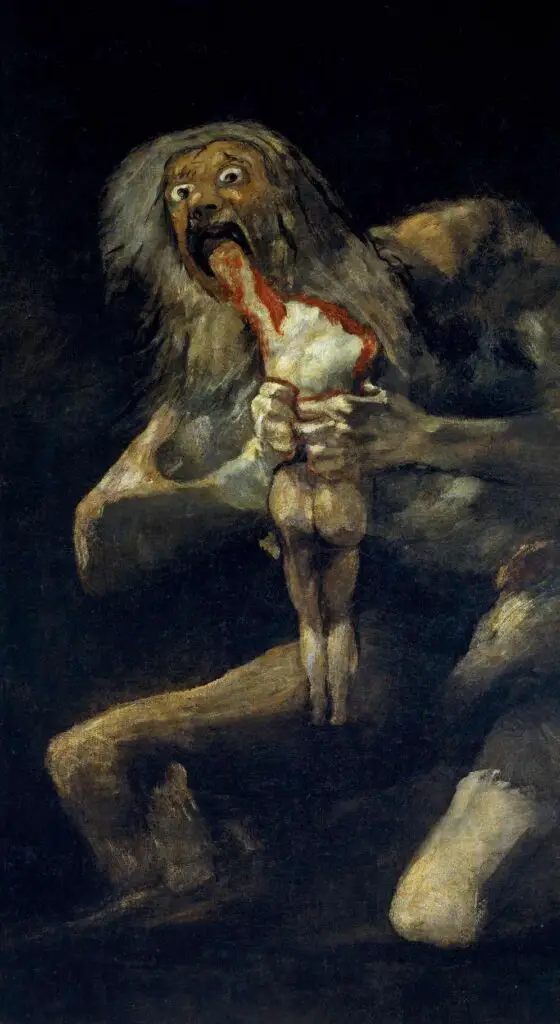
Perhaps the most harrowing, this painting portrays the Titan Saturn consuming one of his children, a nod to the ancient myth. It is a chilling depiction of raw, unfettered violence and the cyclical nature of creation and destruction.
La Leocadia, 1819 – 1823, By Francisco Goya
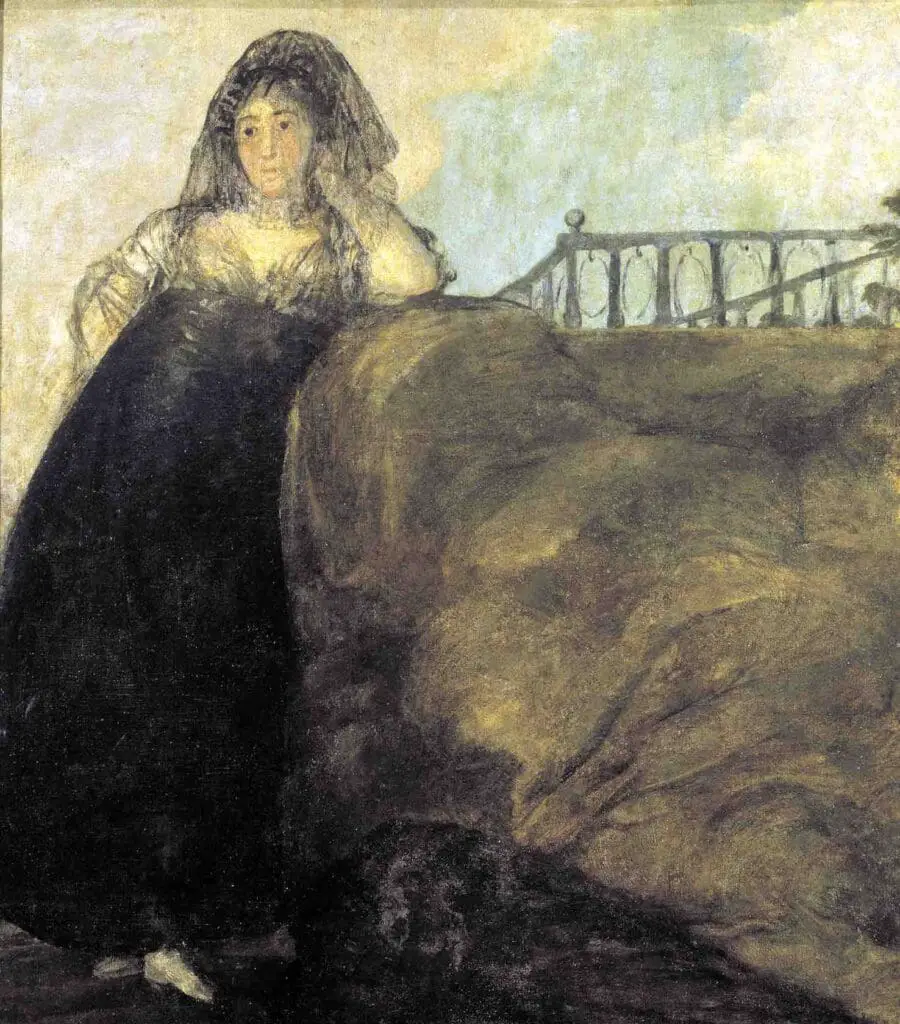
Seemingly more serene than the others, this piece showcases a woman, believed to be Goya’s lover, leaning against a mound. Even in this comparatively calm portrayal, there’s an unmistakable hint of melancholy.
Asmodea, 1819 – 1823, By Francisco Goya
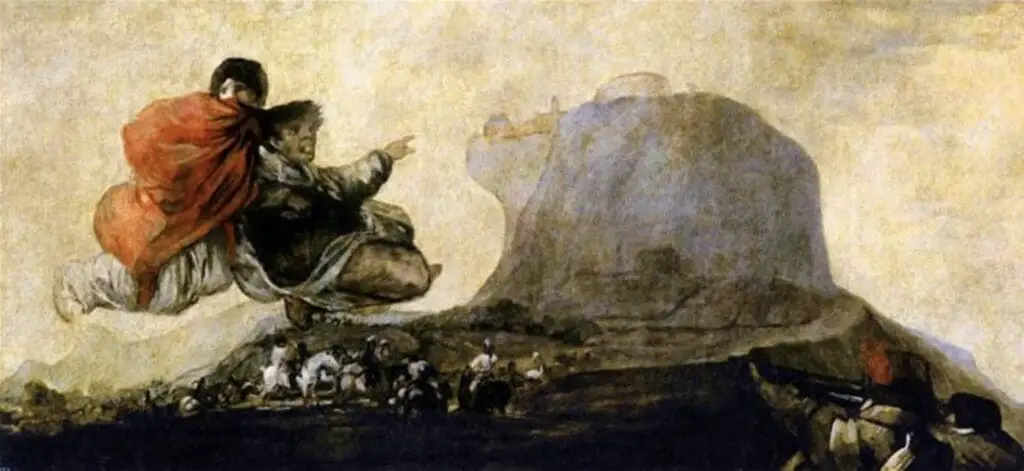
Drawing from biblical demonology, Goya paints the demon Asmodeus overseeing a vast landscape. It’s a grim testament to the dark forces at play in the world.
Each painting in this series is a portal into Goya’s troubled psyche. They remain some of the most profound, enigmatic pieces in art history, a testament to the power of raw emotion and the depth of the human experience. Goya’s Black Paintings is a haunting reflection of a world in turmoil and the inner demons that reside in each of us.
Frequently Asked Questions
What are Francisco Goya’s Black Paintings, and why are they called that?
Francisco Goya’s Black Paintings refer to a series of haunting and intense artworks created by the Spanish artist directly on the walls of his residence. They are called “Black Paintings” due to their dark themes and color palette.
Why did Goya create the Black Paintings, and what was their purpose?
The Black Paintings were not commissioned; they were created by Goya for his personal use and enjoyment. Scholars believe they provide a glimpse into Goya’s inner thoughts and emotions, reflecting his state of mind during a tumultuous period in his life.
How many paintings are included in the series, and what are some notable works within it?
The exact number of paintings in the series is uncertain, but it is generally agreed upon that there are 14 Black Paintings. Notable works include “Saturn Devouring His Son,” “Witches’ Sabbath,” and “Dog Buried in Sand.”
What themes and subjects can be found in Goya’s Black Paintings?
The Black Paintings explore dark and intense themes, including mortality, insanity, war, and the supernatural. Goya delves into the human psyche and reflects on the harsh realities of life.
How did Goya go about creating the Black Paintings, and what techniques did he employ?
Goya applied the Black Paintings directly onto the walls of his residence using oil paint. His technique involved bold brushstrokes and a somber color palette, contributing to the overall dark and mysterious atmosphere.
Why did Goya choose to keep the Black Paintings private, and how were they discovered after his death?
Goya intended the Black Paintings for his personal use, and he did not exhibit them publicly. After his death, they were discovered on the walls of his house, carefully removed, and preserved.
What is the significance of the “Saturn Devouring His Son” painting in the Black Paintings series?
“Saturn Devouring His Son” is one of the most iconic paintings in the series. It depicts the Greek mythological figure Saturn (Cronus) consuming his own child, reflecting themes of brutality, power, and the passage of time.
How do art scholars interpret the symbolism in Goya’s Black Paintings?
Interpretations vary, but scholars generally agree that the Black Paintings serve as a reflection of Goya’s inner turmoil and his commentary on the human condition. The symbolism often involves a critique of social and political issues of his time.
What impact did Goya’s Black Paintings have on the art world and future generations of artists?
Goya’s Black Paintings are considered groundbreaking for their emotional intensity and exploration of dark themes. They have influenced subsequent generations of artists who appreciate the raw and personal nature of Goya’s work.
Where can one view Goya’s Black Paintings today, and are they on display in any public institutions?
The Black Paintings are currently housed in the Museo del Prado in Madrid. Visitors can view these powerful artworks in person and experience the depth and complexity of Goya’s artistic vision.
Anita Louise Art is dedicated to art education, great artists, and inspiring others to find and create their art. We love art that uplifts and inspires. #ArtToMakeYouSmile! #ArtToMakeYouHappy!
If you want to see any of my art, you can find out more by clicking here. If you are interested in what inspires me and my paintings, you can discover more by clicking here.
We have a free newsletter and would love you to be part of our community; you can subscribe to the newsletter by clicking here. I would be happy to talk to you if you have any questions. You can reach me, Anita, by clicking here.
Subscribe to our Anita Louise Art YouTube Channel with great videos and information by clicking here.
Join us for our podcast “5 Minutes With Art.” Spend just 5 minutes a week with us to discover and learn about great art and artists. You can find out more about our podcast by clicking here.
Related Questions
Grandma Moses Sold Her First Painting At Age 79 – And Other Facts
Grandma Moses started painting at age 78 and sold her first paintings at 79. She lived to be 101 years old, and throughout that time, she was a prolific painter that painted over 1500 different paintings. She never had the opportunity to attend art school, so she was a completely self-taught painter.
By clicking here, you can learn more by reading Grandma Moses Sold Her First Painting At Age 79 – And Other Facts.
Art And History – Understanding Our Past
When we study art, it helps us understand and gives us clues about the past. As we see what the artist has painted, we can piece together what life was like during that time in history. Art also helps us better understand the cultures and people who once lived their life.
You can discover more by reading Art and History – Understanding Our Past by clicking here.
Am I Too Old To Start Oil Painting?
You are never too old to learn to oil paint. You can start to oil paint at any age. If Grandma Moses could learn to paint at age 78, she set an example for us all – that you are never too old to learn to paint. There are some advantages to learning to paint when you are older vs. younger.
By clicking here, you can discover more by reading Am I Too Old To Start Oil Painting?

